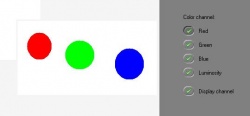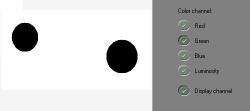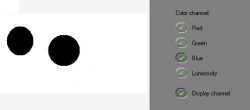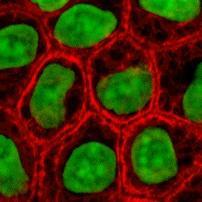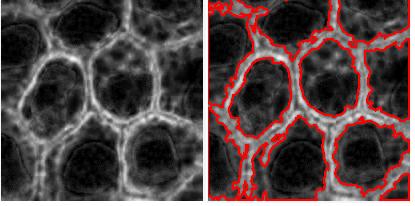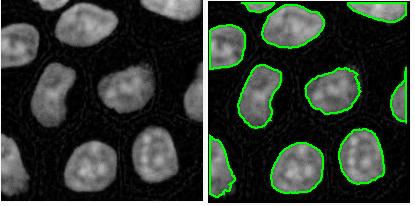Computer Vision Primer: online book of mathematics related to image analysis and data analysis: calculus, topology, linear algebra etc, image analysis software, and applications in sciences and engineering.
RGB channels
From Computer Vision Primer
RGB stands for Red, Green, and Blue. These are the "channels" in a color image. Each pixel has 3 numbers between 0 and 255 assigned to it.
- (255,0,0) red,
- (0,255,0) blue,
- (0,0,255) green,
- (255,255,0) yellow,
- (255,0,255) magenta,
- (0,255,255) cyan,
- (g,g,g) gray, for any g,
- (0,0,0) black,
- (255,255,255) white
Every color image has three color channels - red, green and blue - and the image features you are after may be more pronounced with respect to one of them.
The channel-by-channel analysis allows one to consider each channel of the color image as a separate gray scale image and analyze them as needed. In Pixcavator just click a button in the Analysis tab for the channel you want.
In the example below, the circles are of pure red, green, and blue. As a result, the red circle which is (255,0,0) becomes 255 in the red channel. But 255 is equivalent to white in this gray scale image. So the red circle disappears in the red channel. Similarly, the green circle will disappear if you choose the green channel, etc.
For the user's convenience one extra "channel" is added. It is used for a special combination of the three colors called luminosity.
To see the the channel as a gray scale image, click Display channel. This way you can preview all channels and decide which is the best - before committing to time consuming analysis.
This option is important for some applications such as microscopy. Different features are sometimes better revealed in different channels. Below is the original image with two clear, to the human eye, features: red walls and green "cells".
The two images below are
- the above image presented in the red channel accompanied by its Pixcavator's analysis,
- the image in the green channel and its analysis.
(The match of the colors of the features and the colors of the contours is a coincidence.)
The advice based on these two examples is this:
See Color image analysis for examples.
For more in-depth information, see RGB color model.
A better choice is to analyze all three channels as a whole, see Color images.
Digital discoveries
- Casinos Not On Gamstop
- Non Gamstop Casinos
- Casino Not On Gamstop
- Casino Not On Gamstop
- Non Gamstop Casinos UK
- Casino Sites Not On Gamstop
- Siti Non Aams
- Casino Online Non Aams
- Non Gamstop Casinos UK
- UK Casino Not On Gamstop
- Non Gamstop Casino UK
- UK Casinos Not On Gamstop
- UK Casino Not On Gamstop
- Non Gamstop Casino UK
- Non Gamstop Casinos
- Non Gamstop Casino Sites UK
- Best Non Gamstop Casinos
- Casino Sites Not On Gamstop
- Casino En Ligne Fiable
- UK Online Casinos Not On Gamstop
- Online Betting Sites UK
- Meilleur Site Casino En Ligne
- Migliori Casino Non Aams
- Best Non Gamstop Casino
- Crypto Casinos
- Casino En Ligne Belgique Liste
- Meilleur Site Casino En Ligne Belgique
- Bookmaker Non Aams
- онлайн казино с хорошей отдачей
- スマホ カジノ 稼ぐ
- Trang Web Cá độ Bóng đá Của Việt Nam

